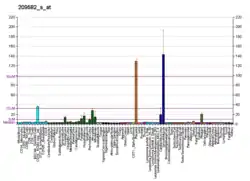CD200
OX-2 membrane glycoprotein, also named CD200 (Cluster of Differentiation 200)[5] is a human protein encoded by the CD200 gene.[6]
The protein encoded by this gene is a type-1 membrane glycoprotein, which contains two immunoglobulin domains, and thus belongs to the immunoglobulin superfamily. Studies of the related genes in mouse and rat suggest that this gene may regulate myeloid cell activity and delivers an inhibitory signal for the macrophage lineage in diverse tissues. Multiple alternatively spliced transcript variants that encode different isoforms have been found for this gene.[6]
See also
References
- GRCh38: Ensembl release 89: ENSG00000091972 - Ensembl, May 2017
- GRCm38: Ensembl release 89: ENSMUSG00000022661 - Ensembl, May 2017
- "Human PubMed Reference:". National Center for Biotechnology Information, U.S. National Library of Medicine.
- "Mouse PubMed Reference:". National Center for Biotechnology Information, U.S. National Library of Medicine.
- "P41217 (OX2G_HUMAN)". Uniprot. Retrieved 16 May 2013.
- "Entrez Gene: CD200 CD200 molecule".
Further reading
- Gorczynski RM (2002). "Evidence for an immunoregulatory role of OX2 with its counter ligand (OX2L) in the regulation of transplant rejection, fetal loss, autoimmunity and tumor growth". Arch. Immunol. Ther. Exp. (Warsz.). 49 (4): 303–9. PMID 11726033.
- Douglas J, Albertson DG, Barclay AN, et al. (1988). "RFLP and mapping of human MOX-1 gene on chromosome 3". Nucleic Acids Res. 16 (18): 9067. doi:10.1093/nar/16.18.9067. PMC 338677. PMID 2902568.
- McCaughan GW, Clark MJ, Barclay AN (1987). "Characterization of the human homolog of the rat MRC OX-2 membrane glycoprotein". Immunogenetics. 25 (5): 329–35. doi:10.1007/BF00404426. PMID 3032785. S2CID 500342.
- Wright GJ, Puklavec MJ, Willis AC, et al. (2000). "Lymphoid/neuronal cell surface OX2 glycoprotein recognizes a novel receptor on macrophages implicated in the control of their function". Immunity. 13 (2): 233–42. doi:10.1016/S1074-7613(00)00023-6. PMID 10981966.
- Hoek RM, Ruuls SR, Murphy CA, et al. (2000). "Down-regulation of the macrophage lineage through interaction with OX2 (CD200)". Science. 290 (5497): 1768–71. Bibcode:2000Sci...290.1768H. doi:10.1126/science.290.5497.1768. PMID 11099416.
- Wright GJ, Jones M, Puklavec MJ, et al. (2001). "The unusual distribution of the neuronal/lymphoid cell surface CD200 (OX2) glycoprotein is conserved in humans". Immunology. 102 (2): 173–9. doi:10.1046/j.1365-2567.2001.01163.x. PMC 1783166. PMID 11260322.
- Strausberg RL, Feingold EA, Grouse LH, et al. (2003). "Generation and initial analysis of more than 15,000 full-length human and mouse cDNA sequences". Proc. Natl. Acad. Sci. U.S.A. 99 (26): 16899–903. doi:10.1073/pnas.242603899. PMC 139241. PMID 12477932.
- Wright GJ, Cherwinski H, Foster-Cuevas M, et al. (2003). "Characterization of the CD200 receptor family in mice and humans and their interactions with CD200". J. Immunol. 171 (6): 3034–46. doi:10.4049/jimmunol.171.6.3034. PMID 12960329.
- Gerhard DS, Wagner L, Feingold EA, et al. (2004). "The Status, Quality, and Expansion of the NIH Full-Length cDNA Project: The Mammalian Gene Collection (MGC)". Genome Res. 14 (10B): 2121–7. doi:10.1101/gr.2596504. PMC 528928. PMID 15489334.
- Chen DX, Gorczynski RM (2005). "Discrete monoclonal antibodies define functionally important epitopes in the CD200 molecule responsible for immunosuppression function". Transplantation. 79 (3): 282–8. doi:10.1097/01.TP.0000149506.61000.86. PMID 15699757. S2CID 19242441.
- Chen Z, Marsden PA, Gorczynski RM (2006). "Cloning and characterization of the human CD200 promoter region". Mol. Immunol. 43 (6): 579–87. doi:10.1016/j.molimm.2005.04.014. hdl:1807/16344. PMID 15955564.
- Shiratori I, Yamaguchi M, Suzukawa M, et al. (2005). "Down-regulation of basophil function by human CD200 and human herpesvirus-8 CD200". J. Immunol. 175 (7): 4441–9. doi:10.4049/jimmunol.175.7.4441. PMID 16177086.
- Otsuki T, Ota T, Nishikawa T, et al. (2007). "Signal sequence and keyword trap in silico for selection of full-length human cDNAs encoding secretion or membrane proteins from oligo-capped cDNA libraries". DNA Res. 12 (2): 117–26. doi:10.1093/dnares/12.2.117. PMID 16303743.
- Kimura K, Wakamatsu A, Suzuki Y, et al. (2006). "Diversification of transcriptional modulation: Large-scale identification and characterization of putative alternative promoters of human genes". Genome Res. 16 (1): 55–65. doi:10.1101/gr.4039406. PMC 1356129. PMID 16344560.
- Matsue H (2006). "CD 200-mediated regulation of skin immunity". J. Invest. Dermatol. 125 (6): x–xi. doi:10.1111/j.0022-202X.2005.23978.x. PMID 16354172.
External links
- CD200+Antigen at the US National Library of Medicine Medical Subject Headings (MeSH)
- Human CD200 genome location and CD200 gene details page in the UCSC Genome Browser.
- Overview of all the structural information available in the PDB for UniProt: O54901 (Mouse OX-2 membrane glycoprotein (CD200)) at the PDBe-KB.
This article incorporates text from the United States National Library of Medicine, which is in the public domain.
This article is issued from Wikipedia. The text is licensed under Creative Commons - Attribution - Sharealike. Additional terms may apply for the media files.





